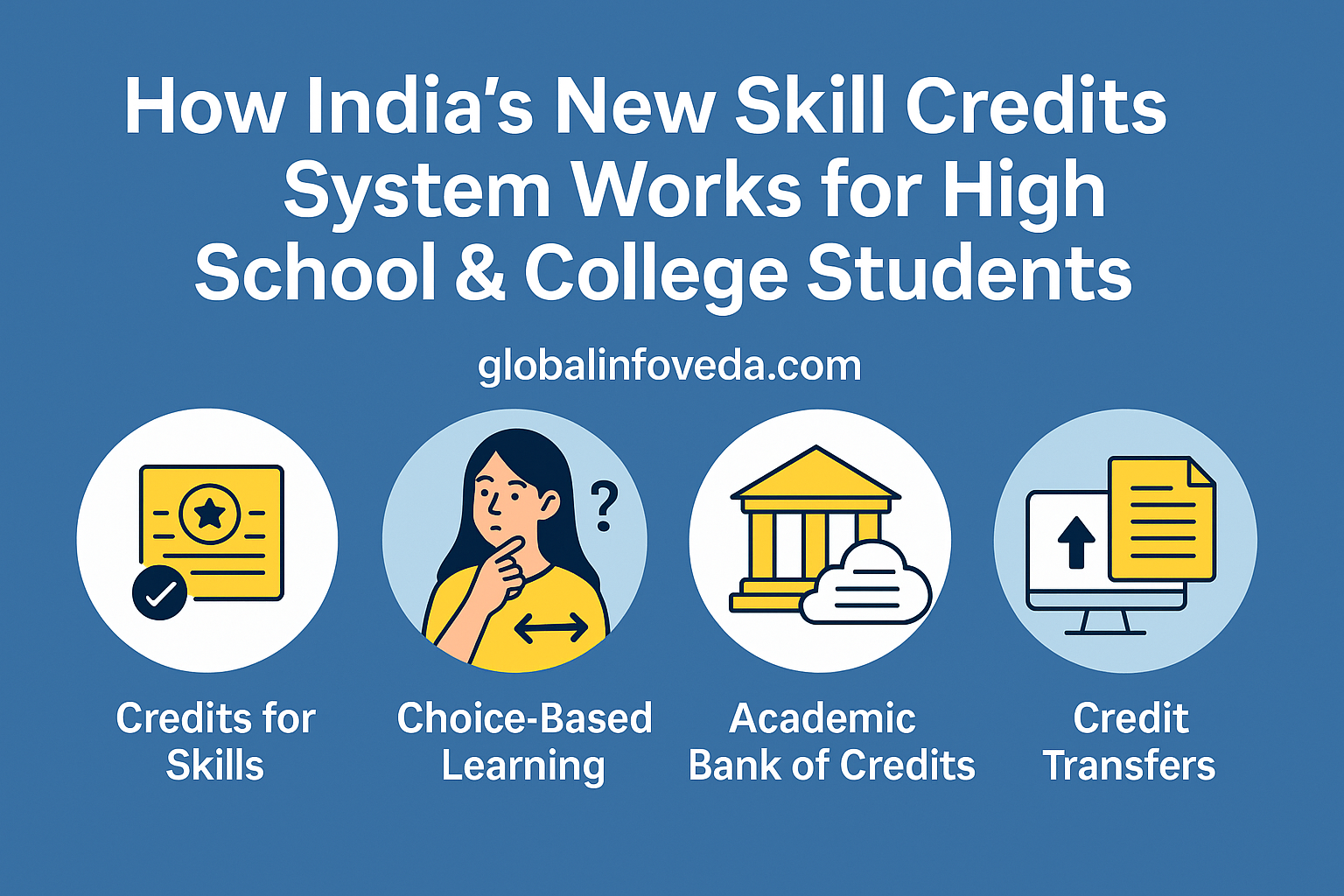🎓 How India’s New Skill Credits System Works for High School & College Students (2025 Update)
India’s education landscape is being reshaped in 2025 with the nationwide rollout of the Skill Credits System, a cornerstone of the National Education Policy (NEP) 2020 and the National Credit Framework (NCrF). This revolutionary system empowers high school and college students to earn formal academic credits for real-world competencies—including skills, internships, entrepreneurial efforts, gig work, certifications, and vocational courses. These credits are portable, stackable, and digitally verified, aligning education with employment in unprecedented ways.
Spearheaded by the Ministry of Education, UGC, AICTE, Skill India Mission, and NCVET, and coordinated with over 12,000+ schools, 600+ universities, and major edtech, MSME, and NGO partners, this system reflects a growing national shift toward modular, personalized, and employment-ready education.
🧾 What Is the Skill Credits System?
The system enables learners from Class 9 to Ph.D. level to:
- Accumulate credits from formal (college), non-formal (online), and informal (hands-on/community) sources
- Store those credits in a unified digital ledger called the Academic Bank of Credits (ABC)
- Transfer, redeem, or combine them to fulfill degree requirements, bridge career gaps, or apply for government jobs and private placements
🧮 Formula: 30 learning hours = 1 credit, mapped to NCrF Levels 1–10, equivalent to school, ITI, diploma, degree, and doctoral stages.
🏫 What It Means for High School Students
High schoolers (Classes 9–12) can:
- Take NSQF-aligned skill electives, from graphic design to solar tech
- Count summer workshops, bootcamps, hackathons, and Atal Tinkering Labs toward their credit totals
- Participate in national competitions, community projects, or startup incubator camps that yield credits
🔄 Credits earned in Class 10 can be carried forward to diploma or Class 11–12 vocational programs
Top Areas of Credit Recognition in 2025 for School Students:
- AI, Web Development, App Design (GUVI, WhiteHat Jr)
- Financial literacy & crypto safety (RBI & NSE FinEdu)
- Electric vehicle maintenance (Skill India + Mahindra Rise)
- Canva + content creation (Meta Blueprint)
- Foreign languages (Duolingo, Rosetta Stone, iTalki)
🎓 For College & University Students
Higher ed students (B.A., B.Sc., B.Com, B.Tech, PGs) can:
- Earn credits for:
- Remote or on-site internships, freelance work, community teaching, and industry collaborations
- Online programs from accredited Indian and global platforms (Coursera, edX, NPTEL, IBM, Google, NSDC Academy)
- Co-curricular pursuits like robotics clubs, startup ventures, or civic leadership roles
- Use credit stacking for:
- Custom specializations (e.g., Cyber Law + Data Ethics + Machine Learning)
- Lateral entry into another university or polytechnic
- Applying for international credit recognition under India-EU or India-UK accords
🧠 Example: A 3rd-year BCA student at VIT completes a 10-credit cybersecurity track (via NASSCOM FutureSkills Prime) + 5-credit research project + 3-credit internship at Zoho to complete a specialization minor.
📚 The Academic Bank of Credits (ABC): How It Works
- Hosted on www.abc.gov.in and linked to DigiLocker + Aadhaar
- Each learner has a 12-digit ABC ID that logs:
- Institution name, duration, level (NCrF)
- Skills gained, badges earned, internship performance
- Credit validity period, transfer eligibility
ABC data is tamper-proof, multi-language accessible, and usable for:
- Re-entry after career breaks
- Degree migration (e.g., IGNOU to IIT or online+offline combos)
- Government job applications or e-portfolios
💡 Key Benefits
| Benefit | Impact |
|---|---|
| Modular Degrees | Customize your path: Journalism + Climate Tech + Motion Design |
| Multidisciplinary Pathways | Mix ITI + Diploma + Degree without redundancy |
| Global Recognition | G2G MoUs signed with UK, Germany, Australia, and UAE institutions for ABC equivalency |
| Skilling for Jobs | NSDC & job boards now scan ABCs for hiring decision support |
| Recognition of Prior Learning (RPL) | Blue-collar workers can upskill and ladder into formal degrees |
📦 What Qualifies for Credits in 2025?
| Category | Examples | Credit Band |
|---|---|---|
| Skill Modules | NPTEL, IBM SkillsBuild, FutureSkills Prime, HarvardX | 1–5 per module |
| Industry Internships | Smart India Hackathon, MSME programs, Startup India internships | 3–10 per term |
| Certification Tracks | AWS Cloud, Meta Ads, Microsoft Azure | 2–7 per certification |
| Vocational Projects | Food processing, drone piloting, repair workshops | 4–12 depending on scope |
| Civic Engagement | NSS/NCC service, NGO-based work | 1–4 per verified stint |
🧪 Major Pilots & Implementation Models
- Delhi Skill & Entrepreneurship University (DSEU): Hybrid programs mixing vocational training + design + AI courses; ABC mapped
- TISS + UNICEF: Social work internships and gender equity bootcamps now credit-linked for BA/MA programs
- IIT Bombay + SWAYAM + Google Cloud: Offer nano-credit bundles for hybrid engineering tracks
- APJ Abdul Kalam Technical University + IBM: Launched 50+ credit-bearing industry nano-courses
- MeitY + AICTE: Skilling dashboards now live for 7 states to track district-level ABC credit use in public colleges
🧾 Final Word
India’s Skill Credit System is a bold leap into the future of learner-centered, employability-focused, technology-backed education. Whether you’re building a career in blockchain, crafting handmade soap, or training to become a solar technician—your efforts are formally recognized, recorded, and ready to travel.
For students, educators, and employers alike, credits are becoming the currency of lifelong learning.
📢 Discover how to align your learning journey with credits, colleges, and careers at GlobalInfoVeda.com
